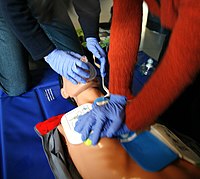
Photo from wikipedia
Abstract Objective The purpose of this study was to determine the extent to which the Theory of Planned Behavior (TPB) accounts for variability in intention to perform cardiopulmonary resuscitation (CPR)… Click to show full abstract
Abstract Objective The purpose of this study was to determine the extent to which the Theory of Planned Behavior (TPB) accounts for variability in intention to perform cardiopulmonary resuscitation (CPR) and to explore which constructs in the TPB most strongly predict intention to perform CPR among college students. Participants: Undergraduate college students (N = 588, 51% women) recruited between September and November 2016. Methods: A cross-sectional survey design. Results: Attitude was the strongest predictor of intention to perform CPR (β = 0.381, p < .001), followed by subjective norm (β = 0.303, p < .001), and perceived behavioral control (β = 0.167, p < .001). The TPB accounted for 51% of the variance in intention to perform CPR (F[3, 536] = 186, p < .001). Conclusion: Attitude and subjective norm are the strongest predictors of intention to perform CPR among college students. Resuscitation trainings that highlight positive outcomes and social norms associated with performing CPR may help bystanders form intentions to perform CPR in an emergency.
Journal Title: Journal of American College Health
Year Published: 2019
Link to full text (if available)
Share on Social Media: Sign Up to like & get
recommendations!